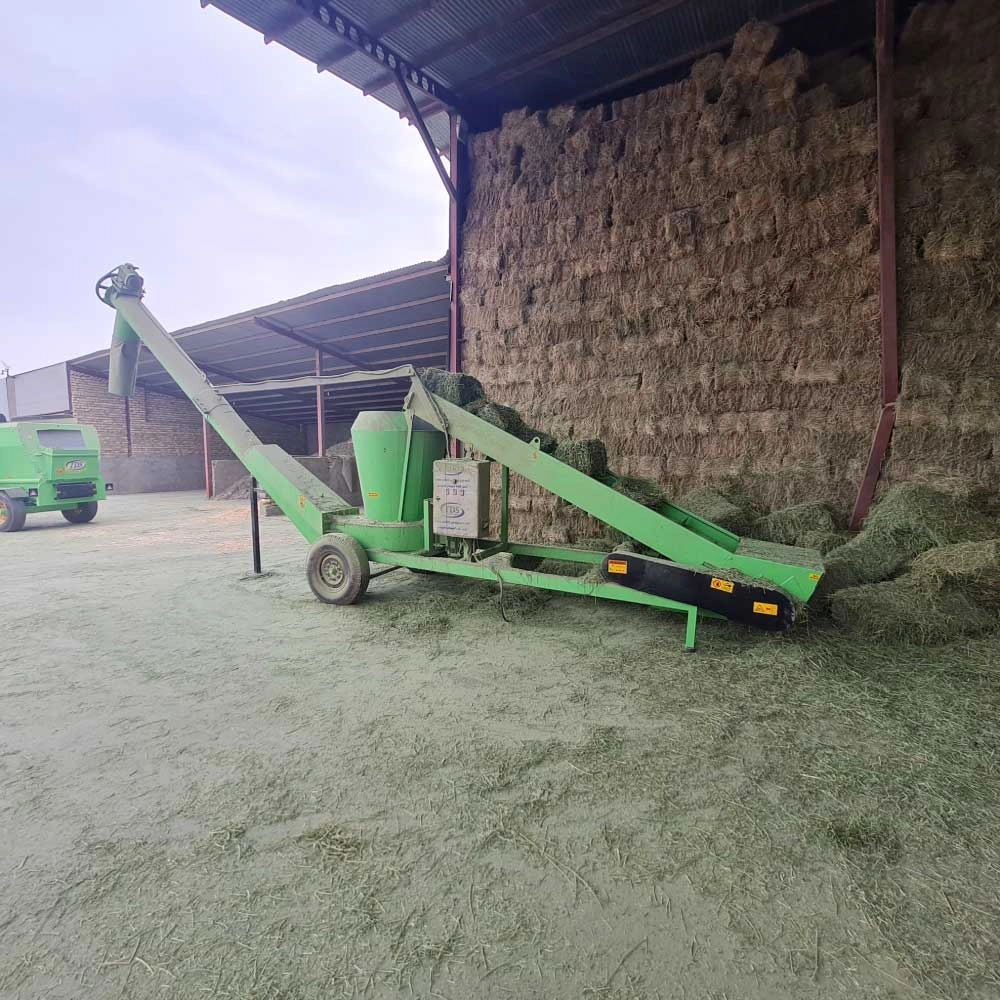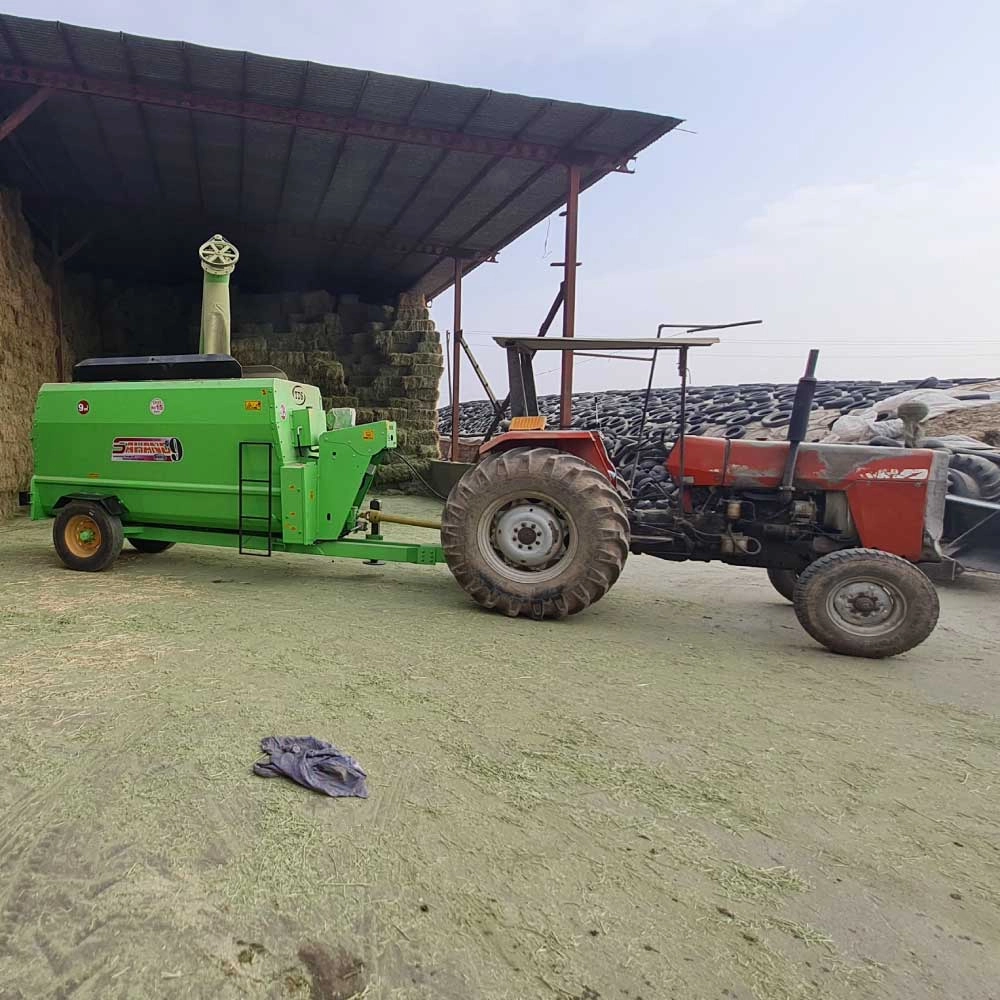What is a Forage Chopper?
One of the most important pieces of equipment in agriculture and animal husbandry is the forage chopper. The purpose of this device is to chop forage that is too large or long for livestock to eat or digest in its original size. This machine cuts the forage into the most suitable sizes (3-5 centimeters for sheep and goats, and up to 7 centimeters for cattle), thereby improving their growth and productivity. Another significant advantage of using a forage chopper is the reduction in fodder waste. If the forage is too large, livestock may not eat it, leading to a considerable amount being discarded.
This machine is capable of chopping various types of livestock fodder, including straw, alfalfa, wheat, and other common forages, into sizes appropriate for the animals. Livestock and poultry farming play a critical role in the agricultural and animal husbandry industries. The type of forage and overall diet of the livestock require careful attention from farmers and breeders. Even the size of the forage is a factor that must be considered. For this purpose, and to make the workload easier for farmers and livestock breeders, different kinds of forage choppers have been developed. These machines feature easy operation and provide forage in appropriate sizes depending on the type of livestock, assisting in their optimal growth.
In this article, we will acquaint you with the different types of forage choppers, their characteristics, and how they work.

Advantages of the Alfalfa Chopper: Enhancing Growth and Improving Livestock Health
The alfalfa chopper is recognized as one of the essential tools in animal husbandry. This device not only contributes to increased livestock production but also improves the health of animals. In this article, we will examine the benefits of using an alfalfa chopper.
1. Facilitating Digestion
One of the most notable advantages of using the alfalfa chopper in animal farming is the facilitation of digestion and nutrient absorption in livestock. By chopping forage into a form that is easily digestible for animals, the intestinal mucosa improves. This helps animals optimally digest and absorb the nutrients available in the forage. Such improvement in the digestive system leads to enhanced growth and increased livestock production.
2. Reducing Forage Waste
Using an alfalfa chopper also reduces forage waste. When forage is chopped, animals can easily consume even the tough and indigestible parts. Consequently, important portions of the forage that would otherwise be wasted are converted into animal mass. This helps farmers utilize their forage more efficiently and avoid economic losses due to waste.
3. Increasing Animals’ Willingness to Eat
Another benefit of chopping forage is the increased willingness of animals to consume it. When forage is chopped into forms that animals find easy to handle, they show greater interest in eating it. This allows farmers to provide better nutrition for their livestock and prevents insufficient feeding.
Reducing Transportation Costs
Using a hay chopping machine helps reduce transportation costs due to the decreased volume and modified shape of the forage. Chopped forage can be transported and stored more compactly, allowing livestock farmers to save on transportation expenses.
Implementing a hay chopping machine as an essential tool in livestock farming enhances productivity and profitability. By facilitating digestion, reducing forage waste, increasing animals’ willingness to eat, and lowering transportation costs, this machine plays a significant role in improving livestock management conditions.

Do not forget that using a hay cutter can help improve animal growth and production while also prioritizing animal health.
Types of Hay Cutter Machines
There are various types of hay cutter machines available in different models and shapes, with varying capacities ranging from half a ton to five tons, designed to meet the needs of individuals in the agricultural and livestock industry. Each of these machines operates differently, cutting livestock fodder in the most efficient way and maximizing feed productivity. The types of hay cutter machines include:
Guillotine Hay Cutter
The cutting method of a guillotine hay cutter is different from rotary cutters. In this machine, the blades move in one direction to slice the hay. The operation of this type of hay cutter involves a large, sharp blade descending vertically onto the hay, chopping it effectively.
Electric Hay Cutter
An electric hay cutter operates through an electric motor and is categorized based on capacity and workload into single-phase, three-phase, and motorized models. The motor power of these machines ranges from 3 to 15 horsepower, and they are designed with capacities from half a ton to three tons, which can be chosen based on the size and needs of the livestock farm. Electric hay cutters have replaced manual models for years and can chop hay more efficiently and in less time, while maintaining higher quality.
Multi-functional Fodder Chopper
This device, also known as the all-purpose fodder chopper, performs multiple tasks simultaneously. In fact, this machine not only chops fodder but also grinds it at the same time. The fodder crushing feature of this device is suitable for various types of fodder, as well as dry bread and fruits.
The operation of the multi-functional fodder chopper works as follows: Fodder is fed into the machine through the top entry door for grinding. A fine mesh is installed at the exit of the machine, which can be adjusted by sliding to control the degree of fodder chopping.
The entry door is easily detachable and can be reinstalled, and by placing a cover over it, the machine can be switched to grinding mode.Another type of fodder chopping machine is the rotary fodder chopper. The blades of this device rotate and strike the fodder to chop it. By installing meshes with holes of varying sizes beneath the blades of this machine, users can adjust the level of fodder chopping.
How Fodder Choppers Work
In general, various types of fodder chopper machines are equipped with steel blades and metal sieves or screens of different sizes. They are designed in a way that ensures maximum efficiency in chopping livestock feed. These machines, with durable bodies and open-mouth designs in various dimensions, operate at a power range of 2 to 15 horsepower to perform their function.
Using these machines is very straightforward. Simply turn on the machine and feed the desired fodder into its inlet. The fodder will then be chopped and discharged through the adjustable outlet. These machines function using two rollers and two or three extremely sharp blades. Depending on the requirement for finer fodder pieces, the number of blades on the machine can be increased.
However, the applications of fodder chopper machines are not limited to chopping livestock feed. Nowadays, these devices are considered essential in the paper industry for shredding and recycling paper to produce pulp. Additionally, in mushroom cultivation units, these machines are used for preparing mushroom compost.




